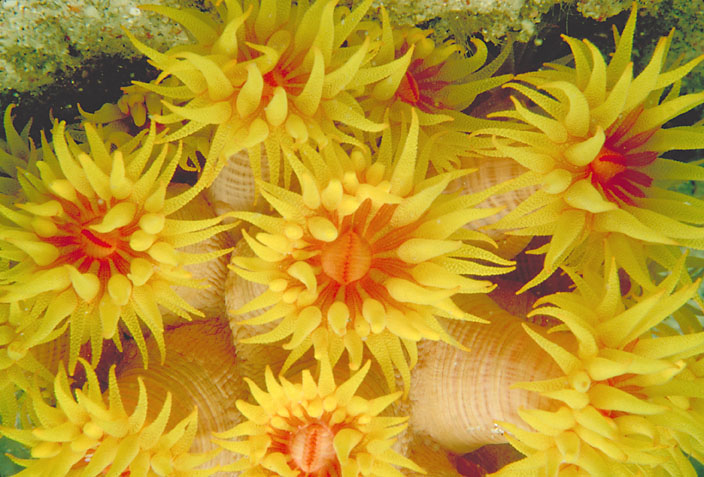Coral reefs are the most diverse marine habitat. Even though they only cover a small part of the ocean floor, they provide a home to more than twenty-five percent of marine life. Bones and parts of ancient animals have formed reefs over long periods of time. Coral reefs are built with the help of polyps. Polyps are individual small animals and organisms. Polyps connect to one another by their tentacles, and over time they harden, and new living ones grow on top of them.
Many coral reefs are found in semitropical and tropical parts of climates. They are found where the water is warm, usually ranging from 61-86 degrees Fahrenheit (16-30 degrees Celsius). There are small strips of coral reef in the North Atlantic , called cold water coral, but most coral thrives in warmer water.
There are two types of coral; soft and hard. Soft coral is not reef-building coral. It is soft, and other types of coral can not grow on top of it, unlike hard coral. Soft coral thrives in nutrient filled water, and collects food that floats past. Coral is alive, and the flesh of the coral is spiky, grainy, and textured, which keep away most predators. Many soft corals are being cut for research, and as a hobby. Coral grown into captivity grows more rapidly, therefore helping the soft coral thrive.
Soft Coral
Hard coral can also be know as stone coral, because it is hard, and feels like a rock. Unlike soft coral, hard coral is hard enough to allow more coral to grow on top of it. It is a home to many animals that burrow in the holes, eat from its surface, and use it as protection.
Hard Coral
There are three types of coral; barrier reefs, atolls, and fringing reefs.
Fringing reefs- Reefs that are continuous with the land mass or mainland
What is happening to our reefs?
There is always a constant threat to the reefs because they are dying off. We have already lost up to 15 percent of our reefs, due to natural and human causes. We can’t destroy the reefs because they provide a home to many animals. Also painkillers and Anti-cancer drugs are being made from chemicals in the reefs. Reefs are another wonder of our Beautiful earth
Sources and links to check out.
http://marinebio.org/
http://en.wikipedia.org/wiki/Marine_biology
http://www.barrierreefaustralia.com/the-great-barrier-reef/coralfacts.htm
http://en.wikipedia.org/wiki/Coral_reef
Sources and links to check out.
http://marinebio.org/
http://en.wikipedia.org/wiki/Marine_biology
http://www.barrierreefaustralia.com/the-great-barrier-reef/coralfacts.htm
http://en.wikipedia.org/wiki/Coral_reef





